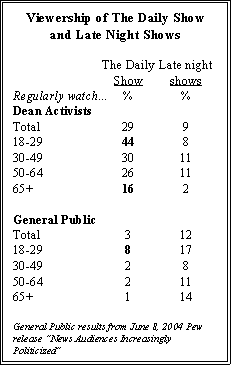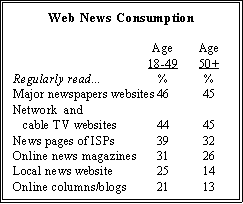 Heavy News Consumers
Heavy News Consumers
Among the most distinguishing characteristics of Dean activists is their intense interest in the news. Not only are they far more avid consumers of news than the general public but the sources they consult follow a substantially different pattern.
Like many Americans, Dean activists pick the daily newspaper as their single most frequently consulted source, although at a substantially higher rate than the general public (68% regularly to 54%). But they stand far apart from the public in their next most common source, National Public Radio. Nearly six-in-ten (58%) regularly listen to NPR, compared with just 16% among the general public.
 Although Dean activists watch cable news channels with the same frequency (38%) as viewers generally, they are more likely to turn to their computers than to turn on the tube. Nearly as many (37%) regularly check the news offered on the home pages of internet service providers and other portal websites such as Yahoo compared with only 13% of the public. By contrast, activists’ viewing of the nightly networks news is a little lower, at 30%, than among the general public, 34% of whom regularly watch these broadcasts.
Although Dean activists watch cable news channels with the same frequency (38%) as viewers generally, they are more likely to turn to their computers than to turn on the tube. Nearly as many (37%) regularly check the news offered on the home pages of internet service providers and other portal websites such as Yahoo compared with only 13% of the public. By contrast, activists’ viewing of the nightly networks news is a little lower, at 30%, than among the general public, 34% of whom regularly watch these broadcasts.
About 45% of Dean activists regularly check the websites of major newspapers and TV networks, and roughly 20%-30% consult other internet news sources including local and foreign news websites, online magazines, and political blogs. By comparison, 10% or fewer of the public regularly tap these sources.
Notwithstanding their taste for online news, Dean activists are also more likely than the general public to read not only print newspapers but also news, literary or political magazines, and to watch television talk shows and C-SPAN.
Broadcast News Sources
Regular consumption of national nightly network news and cable news channels is about the same for both the general public and Dean activists. Public viewership of the Today Show, Good Morning America or the Early Show (22%) is actually higher than among Dean activists (13%).
 Aside from these mainstream sources of news, the public and Dean activists have quite disti
Aside from these mainstream sources of news, the public and Dean activists have quite disti
nct news consumption habits. About twice as many Dean activists regularly watch Sunday morning news shows such as Meet the Press, This Week, or Face the Nation as compared with the public (25% vs. 12%). By a margin of nearly four-to-one (18%-5%), Dean activists are more likely to report watching C-SPAN regularly.
As with the public, there is a sizable age gap in the news consumption habits of Dean activists. Fewer than half of those under age 30 (45%) regularly listen to NPR, compared with nearly two-thirds of those age 50 and older (64%). The differences are even greater in the numbers who regularly watch the NewsHour with Jim Lehrer. Just 5% of activists under 30 regularly watch this program, but it is a major news source for those 50 and older (35% regularly).
Regarding comedy shows, the differences run in the opposite direction. Almost four-in-ten Dean activists under 30 (37%) regularly watch the Daily Show with Jon Stewart, compared with 20% of those age 50 and older. This is in keeping with a pattern among the general public (8% among the young watch Stewart compared with 2% or less among older groups). It is notable, however, that even among Dean activists age 65 and over, regular Daily Show viewership, at 13%, is nearly twice that of the youngest age group in the public.
Far less popular among Dean activists are late night TV shows such as David Letterman and Jay Leno. These shows are regularly viewed by roughly the same proportion of activists (9%) and the general public (12%). The age pattern among late show watchers is the mirror image of that among Daily Show fans: Senior citizens in the public regularly watch late night shows nearly twice as often as Dean activists age 18-29 (14% vs. 8%).
Internet News Sources
 As experienced and frequent web users, Dean activists show a marked preference for obtaining news via the internet compared with the general public. Nearly as many go to network and cable news websites (45%) as to the news broadcasts themselves (51%), and nearly half (46%) regularly visit the websites of major national newspapers.
As experienced and frequent web users, Dean activists show a marked preference for obtaining news via the internet compared with the general public. Nearly as many go to network and cable news websites (45%) as to the news broadcasts themselves (51%), and nearly half (46%) regularly visit the websites of major national newspapers.
While Dean activists are also much more likely than the general public to read printed news magazines such as Time, U.S. News or Newsweek (31% vs. 13%), nearly as many read online news magazines such as Slate or Salon (29%). Younger and older Dean activists are about equally likely to use these kinds of online sources.
Even concerning local news, Dean activists are also more likely than the general public to get information through the internet. By a two-to-one margin, 21% of activists regularly visit websites of their local newspaper or TV station compared with 9% of the public.
Despite their affinity for internet sources, Dean activists are also heavy consumers of print media. Among this highly literate population, regular consumption of literary and political magazines and the New York Times print edition (24%) is at levels comparable to the general public’s consumption of morning TV shows (22%). A tiny proportion of the general public regularly reads magazines such as The Atlantic, Harper’s or the New Yorker or political magazines such as the New Republic (2%). However, Dean activists are ten times more likely to read these sorts of magazines (22%). On the other hand, Dean activists are no more interested than the general public in business magazines such as Fortune and Forbes (6% and 4% are regular readers of these, respectively.)
Extensive Web Use
 Dean activists regularly visit specialized news websites at levels similar to their news magazine consumption. Three-in-ten visit foreign news websites such as the BBC and about one-fifth regularly visit liberal media sites such as TheNation.com or AlterNet.org.
Dean activists regularly visit specialized news websites at levels similar to their news magazine consumption. Three-in-ten visit foreign news websites such as the BBC and about one-fifth regularly visit liberal media sites such as TheNation.com or AlterNet.org.
A significant number (22%) report regularly visiting MoveOn.org, a leading liberal activist site, but relatively few Dean activists visit the major party websites and this holds true for the Democratic Party as well as the GOP. When asked in November 2004, 7% reported regularly visiting the website of the Democratic Party, while fewer than 1% went to the GOP’s site. This is slightly less often than internet users in the general public. (See Pew Internet & American Life Project March 6, 2005 release titled “The Internet and Campaign 2004.”)
Blogs Popular
 Not surprisingly, given their intense interest in politics and the news, Dean activists tend to be blog fans. Four-in-ten report that they at least sometimes read someone else’s blog when they go online. Nearly one-in-five (18%) report regularly accessing blogs such as Talking Points Memo, Kausfiles or the Daily Kos, with 22% sometimes visiting these sites.
Not surprisingly, given their intense interest in politics and the news, Dean activists tend to be blog fans. Four-in-ten report that they at least sometimes read someone else’s blog when they go online. Nearly one-in-five (18%) report regularly accessing blogs such as Talking Points Memo, Kausfiles or the Daily Kos, with 22% sometimes visiting these sites.
Among blog readers, a third (32%) read the Daily Kos (whose founder has acknowledged he was a paid technical adviser to the Dean campaign) at least occasionally. Of all Dean activists, 19% read this blog. Change for America, founded by Dean campaign manager Joe Trippi after leaving the campaign, is the second most popular with 22% of blog readers and 13% of all Dean activists visiting it.
Seriously Wired
All of the Dean activists sampled have access to the internet and the great majority are both experienced and intensive internet users, even compared to other internet users in the general population. More than eight-in-ten (83%) have been online for at least six years, and 18% have been online at least 11 years.
 Nearly all (96%) go online from home, and two-thirds go online from work (68%). The vast majority (70%) have a broadband connection at home, and 77% say they go online “several times a day.” Even among Dean activists age 65 and older, almost two-thirds (65%) access the internet several times a day. By comparison, among those in the general public who go online, half (50%) have broadband connections, and 44% say they go online several times a day.
Nearly all (96%) go online from home, and two-thirds go online from work (68%). The vast majority (70%) have a broadband connection at home, and 77% say they go online “several times a day.” Even among Dean activists age 65 and older, almost two-thirds (65%) access the internet several times a day. By comparison, among those in the general public who go online, half (50%) have broadband connections, and 44% say they go online several times a day.
Dean activists are also more heavily engaged in a wide range of internet activities. Nearly all Dean activists (96%) get news online compared with 73% among all online Americans. A 60% majority has ever read a blog (only 27% in the online general public have done this). As expected, blog readership is highest among the young–73% of activists age 18-29 have ever read someone else’s web log, compared to a still significant 45% among those age 65 and older. A majority of Dean activists (55%) say they have rated a product, service, or person using an online rating system, compared with 26% among the online general public. Nearly one-in-five (19%) have created a profile at Friendster.com., an online social network.
Dean activists and the online general public are similar in the extent to which they send instant messages (42% each), create blogs (13% vs. 10%), or make phone calls online (6% vs. 7%).
Beyond the internet, the Dean activists kept in touch by cell phone, with fully 81% reporting that they had a cell phone; 71% said they had both a cell phone and a landline phone. Ten percent were cell-only, slightly higher than the 7% found among voters in November according to the National Election Pool exit poll. Nearly one-third (33%) of Dean activists under the age of 30 had only a cell phone, considerably higher than the 19% found among this same age group in the general public.
Political Activity Online
By definition, everyone in the Dean activist sample had taken part in at least one specific activity on behalf of the Dean campaign, with much of that activity taking place online or facilitated by the internet. Thus it is not surprising that the vast majority of activists have done such things as signing an online petition (94%), writing to an elected official online (89%), or contributing money to a campaign online (86%). Nearly one-third (30%) have organized a political meeting or event online.


